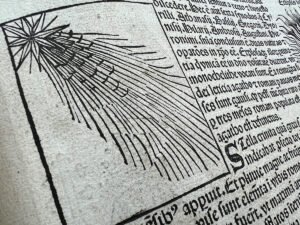 By Emma Laws, Cathedral Archivist
By Emma Laws, Cathedral Archivist
If you visited the Cathedral over the last couple of days your gaze will almost certainly have been drawn upwards to the huge neon star suspended above the Nave. Peter Walker’s sculpture, The Light of Hope Star, is “a symbol of divine guidance, protection and oneness” and it has been making its way across the country since December 2020.
People have been gazing up at the stars since the beginning of time. For centuries, stars remained a mystery until the great Italian astronomer, Galileo (1564-1642), pointed his telescope to the heavens and observed the Milky Way. Half a century later, the Polish astronomer, Johannes Hevalius (1611-1687), compiled his magnificent catalogue of the stars, mapping 600 previously unknown stars and a dozen constellations. The names he gave to certain stars are still used today although we now know there are billions and billions of stars in our galaxy alone.
This week’s image from the Cathedral Library depicts a ‘stella crinita’, or ‘hairy star’. It isn’t actually a star; in ancient times, people perceived comets as stars with long, trailing hair. Comets were believed to be omens of fortune, sometimes good, sometimes bad; indeed, the earliest depiction of Halley’s Comet is in the Bayeux Tapestry where it was believed to have foretold the Norman Conquest of 1066 – good for William, bad for Harold. This later woodcut of the ‘hairy star’ is from the Cathedral’s copy of the Nuremberg Chronicle (1493), an extraordinary illustrated history of the world which references the sighting of Halley’s Comet in 684.
For centuries, scientists debated whether comets were shooting stars or planets, travelling in orbits or straight lines. It was Edmund Halley (1656-1742) who realised that the comet (now named after him) had made several previous appearances and would come round again. Now we know that comets are not ‘hairy stars’ at all but ‘dirty snowballs’, masses of rocky material, dust, gas and ice, orbiting around the Sun. If you didn’t spot the Nishimura Comet in the sky this week (it was closest to the Earth on Tuesday morning), you’ll have to wait approximately another 434 years for it to swing by again. Fortunately, The Light of Hope Star is much easier to spot and it’s here at the Cathedral until 6 January 2024.